Papua Explorers, Raja Ampat, IndonesiaContents of this Issue: MV Kate, Tiger Beach, The Bahamas Scuba Diving In His Living Room? Papua Explorers, Raja Ampat, Indonesia Three More Popular Wrecks Lost Forever Toilet Paper, Dirty Money, Tiny Cockroaches Now Kelp Forests Take a Beating Stop Critter Manipulation Photos Tweaking the Inwater Recompression Protocol A Day in the Chamber and I Wasn’t Bent Those Dreaded Liability Waivers Checking the Internet While Diving Editorial Office: Ben Davison Publisher and Editor Undercurrent 3020 Bridgeway, Suite 102 Sausalito, CA 94965 well worth the time and expense from the March, 2017 issue of Undercurrent
Dear Fellow Driver: Raja Ampat has been on my to-dive list for a while, but it seemed elusive, mostly due to the high cost for two. However, the great 2016 bleach-a-thon in the Pacific, though disputed by some, made me realize that as a hardcore diver I had better get there before it's affected, regardless of the expense. Yes, it does cost a lot, thanks to its remoteness, infrastructure issues, island-hopping nightmares, and supply and demand every diver wants to go there. But, the decline in the Euro, their billing currency, has helped, so seven nights today runs about $4600 for two ($4980 come October); add to that the nearly six days of travel to and fro. But for Raja Ampat, you suck it up.
Every dive I saw unique fish and critters, so many I couldn't possibly list or ID them all, but a few included a Batavia spadefish, a halimeda ghost pipefish on a sand patch, a peacock razorfish, an orangutan crab, wobbegong and walking sharks, and endless crustaceans, eels, and nudibranchs. Once, kneeling on a patch of dead coral, I accidently slid into a dozen Plankobrancus slugs. Yes, I saw dead coral, significant patches on a couple of reefs, and some divers thought they saw signs of dynamite fishing. Regardless, this is gorgeous terrain, though without serious policing, it is not immune to civilization's bad impulses. Raja Ampat comprises four large islands off the coast of what was once Irian Jaya but is now West Papua. Some distance separates the islands, so if you select a resort on Misool, you will be diving in the Misool area and most likely will never get near Waigeo or Batanta. If you go to Waigeo, where you stay will influence what part of Waigeo (or Gam or Fam) you'll be diving. I picked Papua Explorers, on the southern end of Gam Island, an easy travel distance to the Dampier Strait. Upon arrival at Sorong Airport in late October, my buddy and I were met and driven to our hotel. We had arrived a day early because Indonesian airlines have a reputation for blowing flights and we didn't want to miss the noon resort boat, which departs only Sundays or Wednesdays (to charter the three-hour ride any other day will cost $580). The boat was loaded with supplies, so the twelve 12 of us and our luggage made it a tight fit for the long ride. It was my first chance to meet the guests, many of whom were Americans, and two just happened to live 20 miles from me.
A Frenchman named Arno oversees the dive operation. Having lived and dived many years in Indonesia, he's also a marine ecologist and gave a talk on a manta survey they had presented to local officials to stress the need for renewed conservation efforts. Near the central dock, he oversees coral-growing stations that will be used eventually to restore dead reefs. We were encouraged to participate in their "citizen science" to help keep tabs on various species. This isn't just for show. The data collected is used to chart the population of certain species at specific reefs.
At Manta Sandy, where oceanic mantas are hopefully the main attraction, we hit the water, swam to the cleaning station and waited. And waited, while a snake eel poked its head from the sand in the distance. Still, no mantas, which is my normal luck with mantas anyway. So, I turned my attention to the sea floor where a pair of Pegasus seamoths was making their way to nowhere in particular. They don't like walking toward you, so after a couple of maddening minutes of photography futility, I swam off with the other divers to the reefs. And there I was awestruck. Each mound was like an ecologically isolated island, each with its unique growth. First was a huge number of mushroom leather coral in a sea of Halimeda algae and octo corals with occasional branching hammer coral running hundreds of feet. The next mound was dominated by a forest of staghorn coral, then a mound with a massive cluster of cabbage patch coral intermingled with bird's nest and mantipora corals. A huge sponge group, some individuals nearly three feet tall, reminded me of Stonehenge as it stood out monolithically in that sea of cabbage corals. While reef fish were few, it was just mound after mound of packed corals and sponges, without even a sand patch. How do you stage a shot when the beautiful coral cover is that dense?
The dive staff at Papua Explorers knows that's why they get guests from afar and did a splendid job looking out for their customers, loading and unloading gear, and offering whatever assistance one might require. We were well briefed before each dive, -- too well, I might say, given the excessive specificity. Our boat, small and speedy, never had more than six guests, with a guide for every two divers most of the time, and my buddy and I had the same guide every dive. When my buddy caught a cold and had to skip several dives, it was just our guide and me. A local, he pointed out endless subjects I surely would have missed on my own. I had to retrain myself to look at the reef in a manner I had not needed anywhere else I have dived. I had to acquire macro-vision.
Many nights before dinner, I'd make a night dive from the dock -- one could see big cuttlefish in the water -- on the ever-changing house reef. One night it was dominated by crustaceans, lobsters, and spotfin lionfish, while another night it was highlighted by many walking sharks, and I even witnessed a mating attempt. It was always a treat to return to my spacious bungalow, which had a covered deck/porch with a hammock and two reclinable sun chairs, and for snorkeling, a most convenient ladder leading down to the water. The shower had plenty of hot water. The beds were enshrouded with mosquito netting; I saw few bugs, but my buddy had plenty of bites from just walking around. In the absence of air conditioning, a portable fan handled the heat and humidity to some degree, and at night, pointed at me from the foot of my bed, it was ok.
I should note again that when traveling to such a remote outpost, one must leave some slack in one's schedule since airlines are frequently late and may even change the schedule after you've booked (I had to reschedule my return to Bali because Garuda broke the itinerary I had). In fact, though many divers prefer --- even insist upon --- arranging our own trips via the Internet, using a knowledgeable travel agent for Indonesian islands will surely save you time and hassles. For example, I decided to make my first Indonesian stop in Bali. Now I've learned that Jakarta, while a greater distance, has better flights and probably cuts travel time. Because of the extensive travel time and the expense of the trip, every day counts. And seven days at the resort wasn't quite enough. Ten would be better, if your pockets are deeper than mine. -- D.S. Our undercover diver's bio: "Before 2008, I saw myself as a tech worker who just hit the ski slopes every few years, and that's it. Then I got bit by the diving bug. Now I can't see past the ocean. I've made more than 200 dives in the cold and rugged waters of Northern California while shuttling off to various South Pacific and Indian Ocean venues, where the waters are much more comfortable."
|

I want to get all the stories! Tell me how I can become an Undercurrent Online Member and get online access to all the articles of Undercurrent as well as thousands of first hand reports on dive operations world-wide
| Home | Online Members Area | My Account |
Login
|
Join
|
| Travel Index |
Dive Resort & Liveaboard Reviews
|
Featured Reports
|
Recent
Issues
|
Back Issues
|
|
Dive Gear
Index
|
Health/Safety Index
|
Environment & Misc.
Index
|
Seasonal Planner
|
Blogs
|
Free Articles
|
Book Picks
|
News
|
|
Special Offers
|
RSS
|
FAQ
|
About Us
|
Contact Us
|
Links
|
3020 Bridgeway, Ste 102, Sausalito, Ca 94965
All rights reserved.

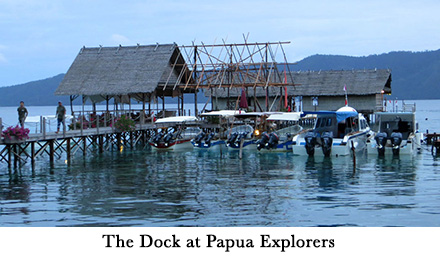 After all, this is the epicenter of the Earth's fish and coral. After my first two dives, I'd already seen a dozen animals I'd never seen before. By week's end, that number was well over 100. Diving Cape Kri, for example, was all about the fish. Thousands upon thousands of jacks, trevally, sweetlips and pickhandle barracuda engulfed me in the mild current. The "Blue Corner of Raja Ampat" might be Sardine's Reef, on the edge of the Dampier Strait. It was a challenging dive because we clamped our reef hooks into a slope, then slowly moved up, leapfrogging and rehooking from bommie to bommie, into an increasingly strong current. But, everywhere were enormous schools of scissortail and blue and yellow fusiliers, with the occasional unicorn fish or jacks, as well as schools of butterflyfish and even a school of 50 spadefish. Incredible. Visibility ran 50 feet (15m) plus in most places, with Damplier straits exceeding 80 feet (25m).
After all, this is the epicenter of the Earth's fish and coral. After my first two dives, I'd already seen a dozen animals I'd never seen before. By week's end, that number was well over 100. Diving Cape Kri, for example, was all about the fish. Thousands upon thousands of jacks, trevally, sweetlips and pickhandle barracuda engulfed me in the mild current. The "Blue Corner of Raja Ampat" might be Sardine's Reef, on the edge of the Dampier Strait. It was a challenging dive because we clamped our reef hooks into a slope, then slowly moved up, leapfrogging and rehooking from bommie to bommie, into an increasingly strong current. But, everywhere were enormous schools of scissortail and blue and yellow fusiliers, with the occasional unicorn fish or jacks, as well as schools of butterflyfish and even a school of 50 spadefish. Incredible. Visibility ran 50 feet (15m) plus in most places, with Damplier straits exceeding 80 feet (25m).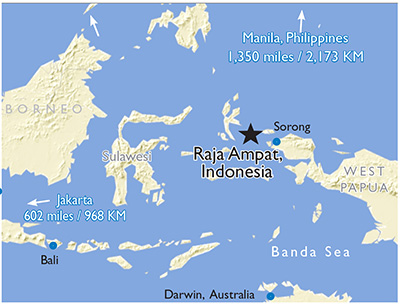 If one weren't looking closely, it might be easy to mistake Papua Explorers Dive Resort for just another village that dots the verdant shoreline every few miles. We motored up to the long dock, staff grabbed our bags, and we ambled down to the attractive local wood-hewn restaurant/central meeting area/main office building on shore. To the right, a path runs behind the charming bungalows (both single and double) that perch on stilts above the water. The dive shop has a gear and wetsuit storage area, a small room to tinker with and curse at your camera outfit, an office and a place to fill tanks. Newish it may be, but they have things wired down nicely. In fact, at the end of our stay, we were given a log sheet with the location and nature of each dive, which helped me ensure I got the spellings correct in my own log book.
If one weren't looking closely, it might be easy to mistake Papua Explorers Dive Resort for just another village that dots the verdant shoreline every few miles. We motored up to the long dock, staff grabbed our bags, and we ambled down to the attractive local wood-hewn restaurant/central meeting area/main office building on shore. To the right, a path runs behind the charming bungalows (both single and double) that perch on stilts above the water. The dive shop has a gear and wetsuit storage area, a small room to tinker with and curse at your camera outfit, an office and a place to fill tanks. Newish it may be, but they have things wired down nicely. In fact, at the end of our stay, we were given a log sheet with the location and nature of each dive, which helped me ensure I got the spellings correct in my own log book.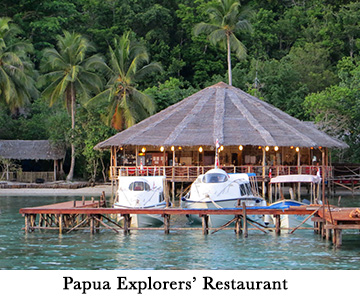 My package included four dives a day, and I intended to make the most of it, refusing to squander a day for a bird watching trip, or an island excursion --compelling as they were. But, I was at the most bio-diverse underwater spot on the planet. I would eat, dive, rest, dive, lunch, dive, rest, dive at night, eat dinner, go to sleep, repeat ... basically liveaboard conditions ... only on land. It wore me down, but I can't argue with the results.
My package included four dives a day, and I intended to make the most of it, refusing to squander a day for a bird watching trip, or an island excursion --compelling as they were. But, I was at the most bio-diverse underwater spot on the planet. I would eat, dive, rest, dive, lunch, dive, rest, dive at night, eat dinner, go to sleep, repeat ... basically liveaboard conditions ... only on land. It wore me down, but I can't argue with the results.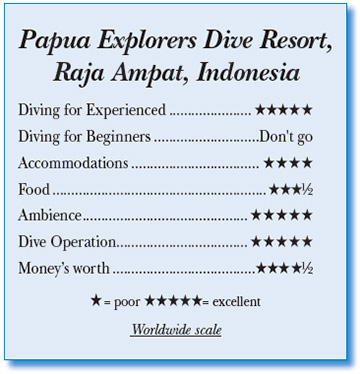 I didn't see many sharks, perhaps 10 blacktip or gray reef sharks, though I
saw wobbegongs, and at night, other reef walkers. Ten large bumphead parrotfish
moseyed by on my first dive, but they were scarce the rest of the trip, as were
Napoleon wrasse. Regardless, I was more than compensated by the huge biodiversity,
which made the trip well worth it. Besides, there are easier and cheaper ways to
see sharks and mantas, but nowhere else to see the complex and complete biodiversity
thriving here.
I didn't see many sharks, perhaps 10 blacktip or gray reef sharks, though I
saw wobbegongs, and at night, other reef walkers. Ten large bumphead parrotfish
moseyed by on my first dive, but they were scarce the rest of the trip, as were
Napoleon wrasse. Regardless, I was more than compensated by the huge biodiversity,
which made the trip well worth it. Besides, there are easier and cheaper ways to
see sharks and mantas, but nowhere else to see the complex and complete biodiversity
thriving here.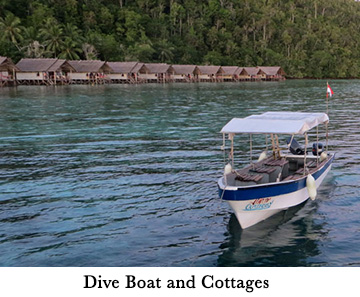 With all this diving, ya gotta eat, and
I ate well. We sat at long tables and every
buffet meal featured a wide variety. Breakfast:
bacon and eggs to dried cereal. Lunch and
dinner buffets were well prepared, and consisted
of several dishes such as seafood -- baked,
sauteed -- pastas, vegetables, locally inspired
cuisine, and meat, cookies and baked goods,
and always fruit plates, but not as sumptuous
as one might expect and no rambutans or dragon
fruit, which I love in the tropical Pacific.
I also started cutting back on consumption
because I found I was never hungry come mealtime
because I'd eaten too much the previous
meal.
With all this diving, ya gotta eat, and
I ate well. We sat at long tables and every
buffet meal featured a wide variety. Breakfast:
bacon and eggs to dried cereal. Lunch and
dinner buffets were well prepared, and consisted
of several dishes such as seafood -- baked,
sauteed -- pastas, vegetables, locally inspired
cuisine, and meat, cookies and baked goods,
and always fruit plates, but not as sumptuous
as one might expect and no rambutans or dragon
fruit, which I love in the tropical Pacific.
I also started cutting back on consumption
because I found I was never hungry come mealtime
because I'd eaten too much the previous
meal.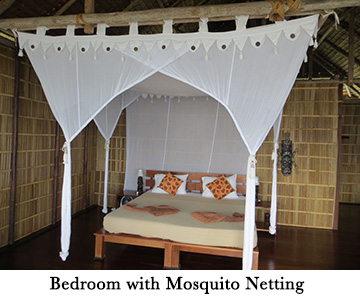 Our dive package included an excursion to the Passage, a high-speed drift dive through a narrow channel that separates Waigeo and the northern tip of Gam. Supposedly it's the owner's favorite dive, but I must have caught it on a bad day. While I was not impressed with the drift dive, I was wowed by a few sheltered underwater alcoves that were overrun with soft corals and large barrel sponges. I could have spent the entire dive just scoping those out. A macro nut would have had a fine time. The one downside is that it's an all-day deal, with only two dives, not three.
Our dive package included an excursion to the Passage, a high-speed drift dive through a narrow channel that separates Waigeo and the northern tip of Gam. Supposedly it's the owner's favorite dive, but I must have caught it on a bad day. While I was not impressed with the drift dive, I was wowed by a few sheltered underwater alcoves that were overrun with soft corals and large barrel sponges. I could have spent the entire dive just scoping those out. A macro nut would have had a fine time. The one downside is that it's an all-day deal, with only two dives, not three. Divers Compass: One can rent all equipment for $145/week; they also rent reef hooks, and sell souvenirs like shirts and hats ... Nitrox was included in diving packages, but the tanks weren't clearly marked ... Take what you want from a refrigerator stocked with beer, sodas, and wine, then write it down, and it's billed upon departure; drinks travel thousands of miles to get here and aren't cheap ... Upon arrival, each guest is given a voucher for a short massage; one can purchase longer massages; my sloppy sunscreen application the first day ruled out any massages out for the duration ... They have a large library of sealife ID books ... they offer a wide variety of nondiving excursions ... WiFI is in the main area and extended to my room, but it was spotty; having a Paypal account was very helpful in paying ... They have a kitty jar for tipping the staff ... In Sorong, we looked for ways to kill time before we departed to Raja the next day, but were warned against venturing out on our own and exploring outside of our Swiss Belhotel, because "it's not safe." ... www.papuaexplorers.com has excellent information about what you need, prices, etc.
Divers Compass: One can rent all equipment for $145/week; they also rent reef hooks, and sell souvenirs like shirts and hats ... Nitrox was included in diving packages, but the tanks weren't clearly marked ... Take what you want from a refrigerator stocked with beer, sodas, and wine, then write it down, and it's billed upon departure; drinks travel thousands of miles to get here and aren't cheap ... Upon arrival, each guest is given a voucher for a short massage; one can purchase longer massages; my sloppy sunscreen application the first day ruled out any massages out for the duration ... They have a large library of sealife ID books ... they offer a wide variety of nondiving excursions ... WiFI is in the main area and extended to my room, but it was spotty; having a Paypal account was very helpful in paying ... They have a kitty jar for tipping the staff ... In Sorong, we looked for ways to kill time before we departed to Raja the next day, but were warned against venturing out on our own and exploring outside of our Swiss Belhotel, because "it's not safe." ... www.papuaexplorers.com has excellent information about what you need, prices, etc.